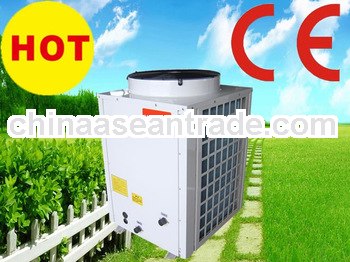residential heat pump,house heating
Heat your home with energy absorbed from the air around you.
Air source heat pumps absorb heat from the outside air. This heat can then be used to heat radiators, underfloor heating systems, or warm air convectors and hot water in your home.
An air source heat pump extracts heat from the outside air i domestic H Household Heat Pump Split For Floor-Heating Hot Water ousehold heat pump for heating house and hot water n the same way that a fridge extracts heat from its inside. It can get heat from the air even when the temperature is as low as -15° C. Heat pumps have some impact on the environment as they need electricity to run, but the heat they extract from the ground, air, or water is constantly being renewed naturally.
How do air source heat pumps work?
Heat from the air is absorbed at low temperature into a fluid. This fluid then passes through a compressor where its temperature is increased, and transfers its higher temperature heat to the heating and hot water circuits of the house. There are two main types of air source heat pump system:
An air-to-water system distributes heat via your wet central heating system. Heat pumps work much more efficiently at a lower temperature than a standard boiler system would. So they are more suitable for underfloor heating systems or larger radiators, which give out heat at lower temperatures over longer periods of time.
An air-to-air system produces warm air which is circulated by fans to heat your home. They are unlikely to provide you with hot water as well.
Component
technical parameters
Items | Unit | JK02R | JK03R | JK03R | JKO5R | JK10R | JK15R | JK2OR | ||||||||
Heating capacity | kw | 6.5 | 10.6 | 10.6 | 18.0 | 35 | 44 | 70 | ||||||||
Water yield | L/H | 155 | 245 | 245 | 420 | 810 | 110 | 1600 | ||||||||
Input power | kw | 1.75 | 2.6 | 2.6 | 4.68 | 9.3 | 11.4 | 18.7 | ||||||||
Running current heating | A | 9 | 13 | 6 | 9 | 18 | 23 | 35 | ||||||||
Power supply | V/PH/HZ | 220V/50HZ | 380V/3PH/50HZ | |||||||||||||
Working | °C | -10°C-45°C | ||||||||||||||
COP |
| 3.9-4.8 | ||||||||||||||
Compressor type |
| Scroll | ||||||||||||||
Compressor brand |
| Copeland/san yo/dan kin | ||||||||||||||
Condenser type |
| Stainless steel plate type heat exchanger | ||||||||||||||
Evaporator |
| Stainless steel plate type heat exchanger | ||||||||||||||
Dimension
|
L |
mm |
1100 |
750 |
750 |
750 |
1484 |
1420 |
2150 | |||||||
W |
440 |
690 |
690 |
690 |
730 |
725 |
1130 | |||||||||
H |
560 |
870 |
870 |
1060 |
1060 |
1365 |
1360 | |||||||||
Weight | kg | 63 | 100 | 100 | 165 | 280 | 360 | 630 | ||||||||
Costs, savings and earnings
Costs
Installing a typical system costs around £6,000 to £10,000. Running costs will vary depending on a number of factors - including the size of your home, and how well insulated it is, and what room temperatures you are aiming to achieve
Savings
How much you can save will depend on what system you use now, as well as what you are replacing it with. Your savings will be affected by:
Your heat distribution system
If you have the opportunity, underfloor heating can be more efficient than radiators because the water doesn’t need to be so hot. If underfloor heating isn’t possible, use the largest radiators you can. Your installer should be able to advise on this.
Your fuel costs
You will still have to pay fuel bills with a heat pump because it is powered by electricity, but you will save on the fuel you are replacing. If the fuel you are replacing is expensive you are more likely to make a saving.
Your old heating system
If your old heating system was inefficient, you are more likely to see lower running costs with a new heat pump.
Water heating
If the heat pump is providing hot water then this could limit the overall efficiency. You might want to consider solar water heating to provide hot water in the summer and help keep your heat pump efficiency up.
Using the controls
Learn how to control the system so you can get the most out of it. You will probably need to set the heating to come on for longer hours, but you might be able to set the thermostat lower and still feel comfortable. Your installer should explain to you how to control the system so you can use it most effectively.
Earnings
You may be able to receive payments for the heat you generate using a heat pump through the government’s Renewable Heat Incentive (RHI). This scheme should be launched in Summer 2013.
For systems installed after 1 August 2011, you may be able to get help with the installation costs of a new air source heat pump through the Renewable Heat Premium Payment scheme.
The benefits of air source heat pumps
Air source heat pumps (also known as ASHPs):
a.could lower your fuel bills, especially if you are replacing conventional electric heating
b.could provide you with an income through the government’s Renewable Heat Incentive (RHI)
c.could lower your home’s carbon emissions, depending on which fuel you are replacing
d.don't need fuel deliveries
e.can heat your home and provide and hot water
f.need little maintenance - they're called ‘fit and forget’ technology
g.can be easier to install than a ground source heat pump, though efficiencies may be lower.
our markers
our certifications




